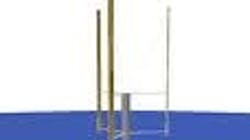A practical ocean-based wind turbine?
Is the this the first practical ocean-based wind turbine?
The Vertiwind wind turbine from Nenuphar in France is said to solve some of the problems of deep-water turbines and reduces the cost of installing and maintaining them.
Traditional ocean turbines have a 50-ton generator mounted 180 ft above the water, making the structure extremely top heavy. To prevent them from toppling over in moderate seas unless they need a flotation system ballasted with tons of material deep underwater (more than 60 ft. down) or they must be securely fastened to the seabed. Both schemes are expensive propositions.
Vertiwind turns the traditional design on its side. As its name suggest, it is a vertical turbine with blades rotating in a plane parallel to the waterline rather than perpendicular to it. The generator sits is a sealed tube just below the blades and only 60 ft above the water. Thus, compared to a conventional horizontal turbine, it is much more stable with lower center of gravity. The lower center of gravity also means the entire wind turbine can float on the surface and only need be moored to the ocean floor. Even better: the simple blades don’t use yaw or pitch controls, and there’s no gearbox. According to the company, Vertiwind can be sit in shallow or deep water.
Vertiwind is using technology that was all but abandoned for onshore wind power more than a decade ago. Vertical-axis designs, which are inherently low to the ground, usually cannot compete with taller, horizontal wind turbines that catch stronger winds at higher altitudes. But low wind speeds should be less of an issue off shore because wind speeds don’t rise as much with height over open water as they do over land.
The company plans to build a 2-MW full-scale prototype in the Mediterranean Sea by the end of 2013.
Resources
Nenuphar
